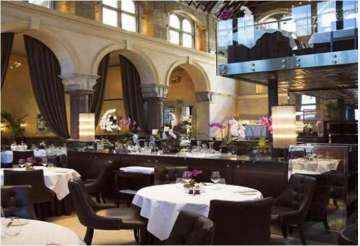18 per cent restaurants may not restart post lockdown
Post-Covid lockdown, it is estimated that 18 per cent single-unit restaurants are likely to shut down between May and July and another 12-15 per cent of restaurants will be part of the second round of closure between September and December.

Post-Covid lockdown, it is estimated that 18 per cent single-unit restaurants are likely to shut down between May and July and another 12-15 per cent of restaurants will be part of the second round of closure between September and December.
A research report called 'Future of Food: Covid-19 Survival Plan' by Indian Federation of Culinary Associations and Tagtaste says that based on the analysis and extrapolation of last available profit and loss statements and balance sheet, and subsequent interactions, an estimated 18% single-unit restaurants won't be able to re-start their units. Chain-brands too run the risk of shutting down 12-15% of their restaurants by December 2020, it said.
It estimates 18% of the outlets are likely to shut down between May and July. There will be a second round of closures in September-December, about 12-15% of the restaurants will be shutting down but the remainder will hold out and invent new ways of conducting their businesses.
As per the report, in financial year 2019-20, the year that ended in March 2020, only 19% outlets delivered an EBITDA of 10% or more, "half of our universe was negative".
The decline can be attributed to multiple factors -- over-expansion, irrational occupancy cost, below average culinary standards, erratic new product development process, lack of training and sometimes hubris.
It noted that too many restaurants opened and then closed too fast, after months, not years. And closures have been an equal-opportunity phenomenon, worldwide.
"People who pitch to investors had to present concepts where the graph runs bottom left to top right. Everything happened on a PowerPoint before you've put one thing in a skillet", it said.
Social media, the stratosphere of influencers, make it seem like every thing's booming, but the places that are bubbling all the time you can count on one hand, the report said.
Businesses are undercapitalized because people completely underestimate what they're going to need.
"ROMO means no traveling, no restaurants, no birthday parties. Choice paralysis has gone out the window because there are few choices to make", it said.
It is too soon to know how the crisis is hitting different age groups, or how much income and wealth each generation is losing; it is far too soon to know how different groups will rebound.
"But we do have early indications; millennials are most vulnerable. They have smaller savings accounts than prior generations. Compounding their troubles, Millennials are, for now, disproportionate holders of the kind of positions disappearing the fastest: restaurant workers, retail workers and gig and contract work, which is evaporating as the consumer economy grinds to a halt", the report said.
India's largest branded restaurant SKU is McAloo Tiki with an estimated annual sales of Rs 400 crore. The Price Elasticity of McAloo, as calculated phase on phase, over its full cycle of existence, works out to 1.065; meaning that a 10% price increase would cause a decline of 6.5% in its volume.
It is important to understand the income-pool that restaurants serve.
Government employees and pensioners are the most stable consumption cluster, now and always, it said.
In the post-Covid19 lockdown, what made restaurants survive in the past can't be the way after. 2015 was the best year for F&B Industry in the memorable history. Post demonetization in November 2016, the performance levers of the industry changed, thanks to the massive discount-driven delivery push.
McDonald's delivers the best store productivity, in terms of performance per square foot, including delivery and in-outlet dining is Rs.2160/sq. ft/month.
The report said that delivery platforms are running out of cash, putting pressure on discount induced delivery business. Last year, delivery platforms' discount spend was 34%, brands shared 50% of the discount spend.
Delivery sales in CY 2019 were 18 times that of CY 2005. In terms of percentage contribution, delivery was 29% of the business in 2019. "In 2020, we are staring at a degrowth of 28% in value sales".
Drive-Throughs are now a lifeline for fast-food chains. With dine-in restaurants shuttered and social distancing paramount, drive-throughs are now providing a crucial source of revenue during the pandemic.
While restaurant dining rooms sit empty, many people have started treating drive-throughs like grocery stores, making only occasional trips but placing larger orders. Punjab based drive-throughs outlets deliver best numbers, the report said.